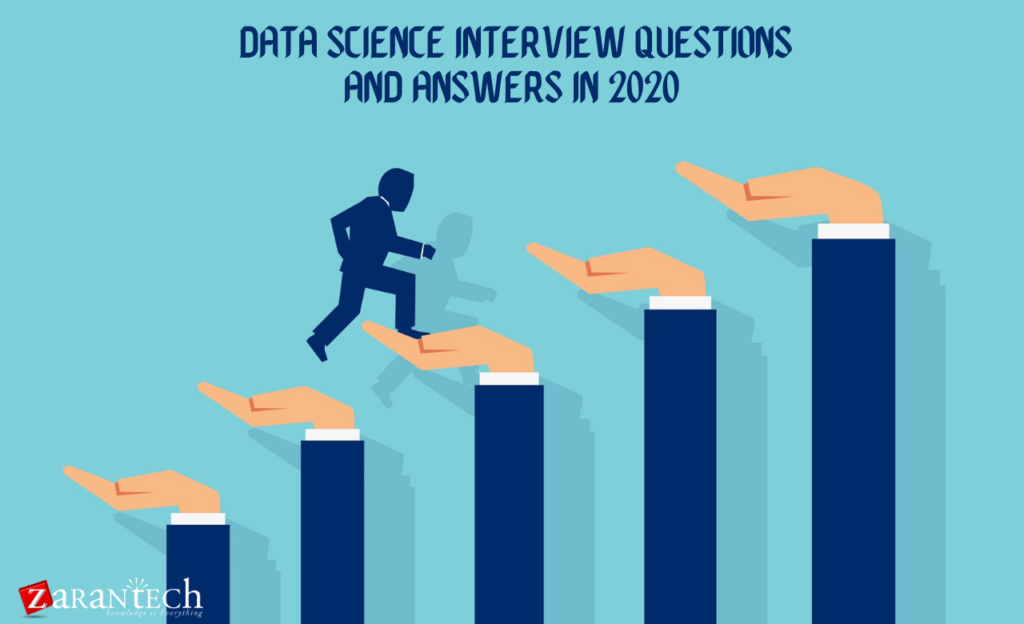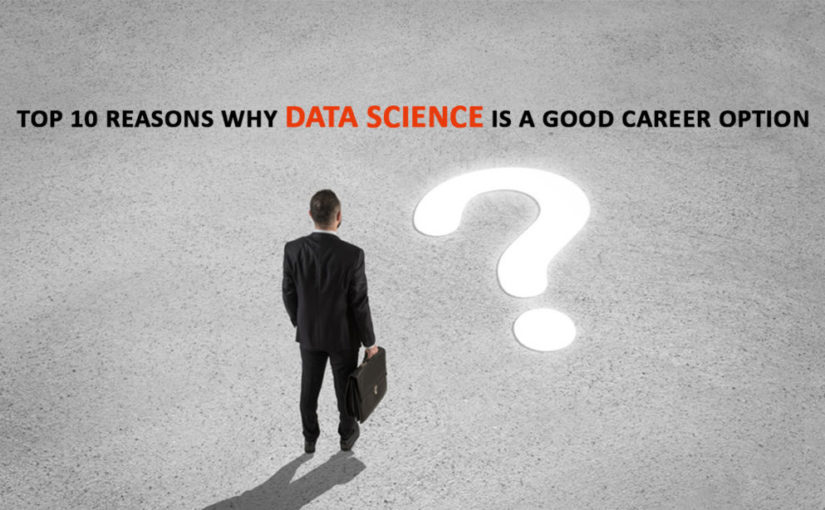Data Science Interview Questions And Answers in 2020
Category: Data Science Posted:May 05, 2020 By: Robert
How to prepare for Data science interview questions?
If you need to effectively get a job in Data science, knowing your stuff and placing it in a neat package with an amazing CV, an exceptional portfolio, and an attractive resume will just get you part of the way through the door.
What will open it is understanding the entire Data science interview process and how to explore it easily. In this guide, we are going to show you what you should know and what you will get here. Well, This is what you’ll learn:
Data Science Interview Questions
We start with a few general Data Science Interview Questions. The rest of the technical and behavioral interview questions are categorized in Data Scientist, Data Analyst, BI Analyst, Data Engineer, and Data Architect.
Data Analyst, BI analyst, data engineer, and data architect related question will be mentioned in the 2nd part of the same article.
Data science interview questions include a few Statistics Interview Questions, Computer Science Interview Questions, Python Interview Questions, and SQL Interview Questions. These are:
1. How do data scientists use statistics?
If we consider data science as a field, we can recognize a few pillars: it is based upon Mathematics, Probability, Statistics, Economics, Programming, Data visualization, Machine Learning and Modeling in general, etc. Now, we could improve this structure by ignoring Mathematics as a pillar, as it is the premise of every science. Then, we could assume probability is an essential part of statistics and keep streamlining further until arriving at three genuinely independent fields: Statistics, Economics, and Programming. Programming is only a tool for emerging ideas into solutions. On the other aspects, Economics is more about ‘business thinking’ about an issue. Therefore, the entirety of a data scientist’s work comes down to statistics.
- One could argue that Machine Learning is a different field, but it is actually an iterative, programmatically, effective application of statistics.
Models, for example, linear regression, logistic regression, decision trees, and so on. are altogether developed by statisticians. Their forecasts are simply statistical inferences based on the original distributions of the data and making assumptions about the distribution of future values.
- Deep learning? All things considered, one of the most widely recognized techniques for backpropagation is called: ‘Stochastic gradient descent’ and the word ‘stochastic’ is a probabilistic term, along these lines, falling inside the field of statistics.
Data visualizations also could fall under the umbrella of descriptive statistics. All things considered, a visualization usually aims to describe the distribution of a variable or the interconnection of a few distinct factors.
One notable exception is data preprocessing. That is an action that is mainly related to programming and regularly doesn’t require statistical knowledge. That is the reason data engineers and data architects exist. They need not be proficient in statistics, that is the data scientist’s job. Finally, there is an exception to the special case, statistical data preprocessing. Here we have the making of dummy factors, feature scaling, regularization, etc. While preprocessing tasks in their execution, they require strong statistical knowledge.
And, there you have it, the interview version of the appropriate answer ‘Data scientists use statistics in nearly all that they do’.”
2. What’s the difference between SAS, R, And Python Programming?
SAS is one of the most well-known analytics tools used by probably the biggest organizations all over the world. It has a great statistical function and a Graphical User Interface. However, it is too expensive to be eagerly adopted by smaller enterprises or individuals. On the other side R, is a robust tool for Statistical Computation, Graphical Representation, and Reporting.
3. What is the distinction between WHERE and HAVING clauses in SQL?
Adding a WHERE Clause to a query enables you to set a condition which you can use to indicate what part of the data you need to retrieve from the database.
HAVING is a clause frequently implemented with GROUP BY on the grounds that it refines the output from records that don’t fulfill a specific condition. HAVING should be embedded between the GROUP BY and ORDER BY clauses. In a way, HAVING resembles WHERE but applied to the GROUP BY block.
On certain events, an identical result could be obtained by executing a similar condition, either with the WHERE or with the HAVING clause.
The main distinction between the two conditions is that HAVING can be applied for subsets of the aggregated group, while in the WHERE block, this is prohibited. In other words, after HAVING, you can have a condition with an aggregate function, while WHERE can’t utilize aggregate functions inside its conditions.
What Do Data Scientist Interview Questions Cover?
You unquestionably can’t turn out badly by getting acquainted with:
- Python programming interview questions;
- algorithm interview questions;
- statistician interview questions (including linear regression interview questions);
- R interview questions;
- Data scientist behavioral inquiries;
- SQL inquiries questions.
It’s actually an apparently unending list (which we’ll cover in detail in our subsequent articles). And, that is not surprising, as data scientists are frequently expected to be a jack-of-all-trades. All in all, what data scientists interview questions would it be a good idea for you to rehearse? For the time being, here are 10 guides to kick you off.
1. What is Normal distribution?
A distribution is a function that shows the possible values for a variable and how frequently they happen.
To answer this question, you are probably going to need to initially characterize what distribution is.
In this way, in statistics, when we utilize the term distribution, we typically mean probability distribution. Here’s one meaning of the term:
A Normal distribution, otherwise called Gaussian distribution, or The Bell Curve, is likely the most widely recognized distribution. There are a few significant reasons:
- It approximates a wide variety of random variation.
- Distributions of sample imply with huge enough sample sizes could be approximated to Normal, after the Central Limit Theorem.
- Every single computable statistics are exquisite.
- Choices dependent on Normal distribution experiences have a good track record.
What is significant is that the Normal distribution is even around its mean, with a concentration of observation around the mean. In addition, its mean, median and mode are the same. At last, you should get an additional point if you mention that 95% of the data points from a Normal distribution are situated inside 2 standard deviations from the mean, and 99.7% of the data points are situated inside 3 standard deviations from the mean.
Now, you might be likewise expected to give an example.
Since numerous biological phenomena are normally distributed it will be the most effortless to go to a biological example. Attempt to feature all realities that you just referenced about Normal distribution.
Let’s focus on the height of individuals. You know a few individuals that are exceptionally short and a few individuals that are extremely tall. You also know a bit more individuals that are short but not very short, and approximately an equivalent amount that is tall, but not very tall. A large portion of your associates, though has a very similar height, center around the mean height of all individuals in your area or country. There are a few differences that are mainly geographical, but, the overall pattern is such.
2. R has a few packages for taking care of a specific issue. How would you choose which one is best to utilize?
R has extensive documentation online. There is typically a complete guide for the utilization of popular packages in R, including the analysis of concrete data sets. These can be helpful to find out which approach is most appropriate to solve the current issue.
Just like with some other script-language, it is the responsibility of the data scientist to pick the best way to solve the current issue. The decision, for the most part, relies upon the issue itself or the particular nature of the data (i.e., size of the data sets, the type of values, etc).
An interesting point is a tradeoff between how much work the package is saving you, and how much of the functionality you are sacrificing.
It bears also referencing that because packages accompany constraints,as well as a benefit if you are working in a team and sharing your code, it might be wise to assimilate to a shared package culture.
3. What are interpolation and extrapolation?
Some of the time you could be posed a question that contains mathematical terms. This shows you the significance of knowing mathematics when getting into data science. Now, interpolation and extrapolation are two very similar concepts. The two of them predicting or deciding new qualities dependent on some sample information.
There is one subtle distinction, though.
Say the range of values we’ve got is in the interval (a, b). If the values we are predicting are inside the interval (a, b), we are discussing interpolation (inter = between). If the values we are predicting are outside the interval (a, b), we are discussing extrapolation (extra = outside).
Here’s one example.
suppose you have the number sequence: 2, 4, _, 8, 10, 12. What is the number in the blank spot? It is clearly 6. By solving this issue, you interpolated the value.
Presently, with this information, you realize the sequence is 2, 4, 6, 8, 10, 12. What is the next value in line? 14, right? Well, we have extrapolated the following number in the sequence.
Finally, we should connect this question with data science a bit more. If they ask you this question, they are presumably searching for you to expand on that.
When we are doing predictive modeling you will be trying to predict values that are nothing unexpected. Interpolated values are commonly considered as reliable, while extrapolated ones are less reliable or sometimes invalid. For example, in the grouping from over: 2, 4, 6, 8, 10, 12, you might need to extrapolate a number before 2. Ordinarily, you’d go for ‘0’. However, the natural domain of your problem might be positive numbers. In this case, 0 would be an inadmissible answer.
In fact, we are faced with issues where extrapolation may not be allowed because the pattern doesn’t hold outside the observed range, or the domain of the event is … the observed domain. It is very uncommon to find cases where interpolation is problematic. Please bear in mind that last bit and remember to specify it in the interview.
4. What is the difference between population and sample in data?
A population is the collection of all items of interest to our study and is usually denoted with an uppercase N. The numbers we’ve gotten when utilizing a population are called parameters.
An example is a subset of the population and is signified with a lowercase n, and the numbers we’ve gotten when working with an example are called statistics.
That is more or less what you are expected to say.
Further, you can spend some time exploring the peculiarities of observing a population. On the other hand, all things considered, you’ll be asked to dive further into for what reason in statistics we work with samples and what types of samples are there.
In general, examples are substantially more proficient and considerably less costly to work with. With the best possible measurable tests, 30 example perceptions might be sufficient for you to take a data-driven decision.
Finally, samples have two properties: randomness and representativeness. A sample can be one of those, both, or neither. To conduct statistical tests, which results you can utilize later on, your example should be both random and representative.
Think about this simplified situation.
Let’s assume you work in a firm with 4 divisions: IT, Marketing, HR, and Sales. There are 1000 people in each department, so the sum of 4000 people. You need to assess the general attitude towards a choice to move to another office, which is vastly improved within, but it is situated on the other side of the city.
You choose you would prefer not to ask 4000 people, but 100 is a pleasant example. Now, we realize that the 4 groups are actually equivalent. In this way, we expect that in those 100 people, we would have 25 from each department.
1) We pick 100 people (out of 4000) randomly and understand that we have 30 IT, 30 Marketing, 30 HR, and 10 from Sales. Clearly, the assessment of the Sales division is underrepresented. We have a sample, which is random but not representative.
2) I’ve been working in this firm for a long time now, so I have many friends on top of it. I choose to ask the opinion of my friends from every division because I need them to feel good in the workplace. I pick 25 individuals from every division. The sample is a representative but is not random.
‘In the main case, we have underrepresented some groups of individuals. In the subsequent case, we’ve settled on a choice dependent on a particular circle of individuals and not the general public’.
If I want it to be random and representative, I will pick 25 individuals from IT at random, then 25 individuals from Marketing at random, same for HR and Sales. Along these lines, all groups will be represented, and the sample will be random.
You can choose to avoid that detailed explanation, or better ask them if they need you to jump further into the topic and then impress them with your detailed understanding.
5. What are the steps in making a decision tree?
Initially, a decision tree is a flow-chart diagram. It is amazingly easy to read, comprehend, and apply to a wide range of issues. There are 4 stages that are significant when constructing a decision tree.
- Start the tree. In other words, find the starting state – perhaps a question or idea, depending upon your context.
- Include branches. When you have a question or idea, it branches out into 1,2, or a wide range of branches.
- Include the leaves. Each branch closes with a leaf. The leaf is the state which you will reach once you have pursued a branch.
- Repeat 2 and 3. We then repeat stages 2 and 3, where the beginning stages are the leaves until we finish off the tree. At the end of the day, each question and the possible result should be included.
Contingent upon the setting you might be required to include extra advances like total the tree, end a branch, check with your group, code it, send it, and so forth.
In any case, these 4 stages are the primary ones in making a choice tree. Regardless of whether to incorporate these additional means truly relies upon the position you are applying for.
If you are applying for certain data science projects to the management position, you might be relied upon to state: ‘Validate with all stakeholders to ensure the quality of the decision tree’.
If you are going for a data scientist job, you might be expected to clarify more about the programming language and library you mean to utilize. This also incorporates the motivation behind why you’d pick that library.
6. How is Machine Learning deployed in real-world scenarios?
This question is a bit tricky. Model deployment is a part of a data science job, but in fact, the efficient model deployment is all the more frequently identified with engineering, software development, cloud computing, etc. As such, to ensure everything is correct, you would do well to go to your IT division or contract a Computer scientist in your team.
Presently, there are 3 significant steps:
1.When you train a model, you should save it, or better store it in a file. There are various manners by which this could be accomplished. The general ‘Pythonic’ ways are through pickle or joblib. However, libraries, for example, TensorFlow deal with significantly complicated model objects and along these lines, they offer ad hoc functions for deployment. Often they look like this: .save(‘filename’).
This part of the procedure is constantly done by the data scientist, ML engineer, or whoever is in charge of the model training.
2. Computing instance. AWS and Microsoft Azure offer computing instances or cloud-based environments that can run the model you’ve recently made. Most likely, you can share the file with your associates through email or Messenger, but more frequently, there will be some cloud that handles the deployment. The computing instance should be set-up to communicate with all other frameworks that feed the input or/ and require the output of the model.
3. Job scheduler. Having a model and a place to run it, you can determine when and how to run it. That could be at once in a week, once per day or every time an event happens (for example a transaction, new user registration, and so on.). At the ideal time, new data would be taken, stacked, cleaned, preprocessed, fed to the model, and so forth until you arrive at the desired result.
Having finished these 3 steps, you are practically done.
You will have a model, running on some cloud at pre-scheduled times. When you have an output, you can return it to a Python notepad, or better connect it to one more framework (that could be considered as a part of 2.). Contingent upon your needs, it could be a web application (for example a recommender framework gives data about a specific client and shows them pertinent outcomes), or some kind of visualization software, for example, Tableau or PowerBI which would analyze your data in real-time.
Unnecessary to push, 2. and 3. would once in a while be a data scientist’s primary job. Still, in a smaller team that may fall on them, as well.
7. What is K-means clustering? How might you select K for K-means?
The fundamental objective of clustering is to group individual observations so that the observations from one group are very similar to one another. Furthermore, we’d like them to be totally different from the observations in different groups. There are two fundamental types of clustering: flat and hierarchical. Hierarchical clustering is substantially more tremendous in light of the dendrograms we can make, however, flat clustering strategies are significantly more computationally effective. Along these lines, we typically decide for the later.
K-implies clustering is the most prominent example of flat clustering.
It comprises finding K clusters, given their mean distance from the centers of the clusters. K represents the number of clusters we are trying to identify. This is a value choosing before clustering.
Presently, the optimal number of clusters is clearly what we are normally keen on.
There are a few different ways to approach that, but, the most widely recognized one is known as: ‘The Elbow Method’.
There, we take care of the clustering problem with 1, 2, 3, 4, 5, 6, etc various clusters. We then plot them on a graph where on the x-axis we have got the number of clusters, while on the y-axis, the WCSS (within-cluster sum of squares). The subsequent picture looks like a human elbow. Where the kink is signified the optimal clustering solution. Also, that is the way you pick the ‘K’ in K-means.
8. What are the disadvantages of a linear model?
This is probably the oddest question you could be asked. It is like being asked: ‘what are the disadvantages of playing tennis shoeless?’ You needn’t bother with shoes to play tennis, but it is much better if you do.
Presently, the most widely recognized linear models are the linear regression model and a linear time series model. Accordingly, we should respond to the question in that context.
The single greatest preferred advantage of a linear model is that it is simple. From that point, there are mainly disadvantages and limitations.
In this way, we should concentrate on the main 3 cons of utilizing a linear model.
1.The linear model implies a linear relationship.
A linear model assumes that the independent variables clarify the dependent one(s) in a linear way, for example, a = bx + c. No powers, exponents, logarithms, and so on are permitted. Clearly, this is an extraordinary simplification, the real world isn’t linear. Utilizing a linear model, would either disregard some patterns or force us to execute complicated transformations power to reach a linear representation.
2. Data must be independent.
In the general case, that is not always true, but in 95+% of the linear models conducted in practice. Most linear models assume that the variables in the model are not collinear. Alternatively, we observe multicollinearity or the math behind the model estimation ‘brakes’. Assuming that the variables are independent is obviously a courageous articulation especially because we are constrained to a linear relationship (if we had exponents and logarithms, the probability that they are collinear would drop drastically).
3. Outliers are a big, big issue.
Since linear models expect linearity, having values that are too huge, or too little in regards to any component might be devastating for the model. All focuses are required to be near some line, which as you can imagine is rather unrealistic. To deal with that we often complicate the linear model in ways that practically make it behave like a nonlinear one.
9. Describe a time when you were under pressure.
Each Hiring Manager needs to ensure you can deal with the pressure of the job. Is it accurate to say that you are somebody who is probably going to abandon the boat when things get a little tough? Each firm needs individuals that are reliable. All jobs include a certain element of pressure; some more than others, obviously. Your assignment here is to give a case of a stressful situation and show how you coped with it.
Here’s a case of such a circumstance:
I was under significant pressure before taking my GMAT test. I required a great grade so as to be admitted to the graduate school that I am currently graduating from. Half a month prior to the exam, I saw that I was getting apprehensive. Two things helped me handle the pressure much better; I started sleeping for at least 7 hours (going to bed earlier in the evening) and I dedicated at least one hour a day to sports activities. This had a hugely positive impact on my concentration and stress level.
10. How would you add value to our company?
Despite the fact that as opposed to selling a pen, you have to sell the possibility of you finding the activity. This is the thing that the recruiter is asking that you do. You have to persuade him/her that you will increase the value of the organization. But how are you going to have the option to advise how you would increase the value of the organization before having worked for the organization?
Most candidates will start by posting their qualifications, work experience, personal traits, achievements and they plan to push the right button, incidentally.
Thus, when confronting the “sell me this pen” task, most people start describing the pen’s properties; it is an extraordinary pen, writes very well, it is gleaming and smooth, and so on.
It is normal to concentrate on your characteristics and capabilities when asked how are you going to increase the value of the organization.
In any case, this is a snare.
Most people would do only that. They will clarify that they are extraordinary and that they are qualified. but, that fails to answer the question itself, correct? How are you going to add value? Analogically, the person who is being sold a pen can ask “For what reason do I need this pen?” Instead of falling for this trap and reacting like every other person, you can rather show that you are different by using an alternative approach.
We hope these questions and answers will help you to prepare your coming interviews in the best way with full confidence.
If you are planning to boost your skills, choose our best online training platform, and learn from industry experts. So what are you waiting for? Click here, to skyrocket your career with the unique learning needs because Learning Never Exhausts The Mind.





 99999999 (Toll Free)
99999999 (Toll Free)  +91 9999999
+91 9999999